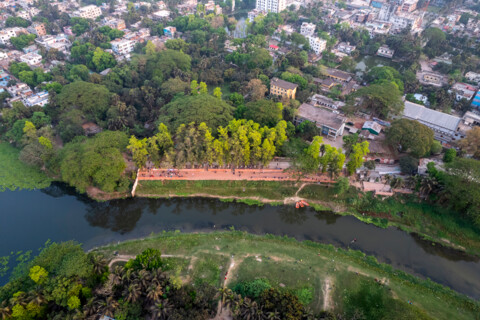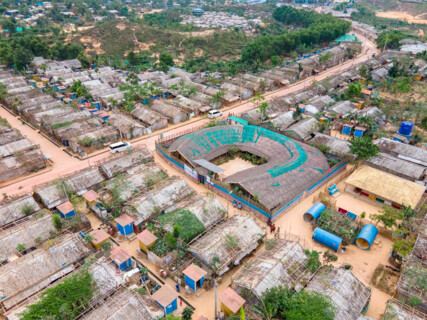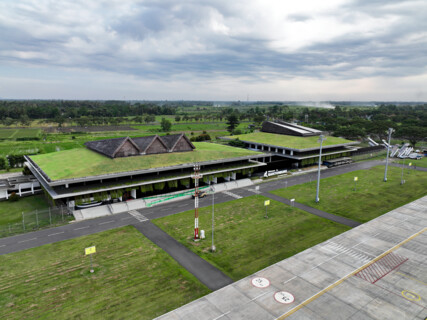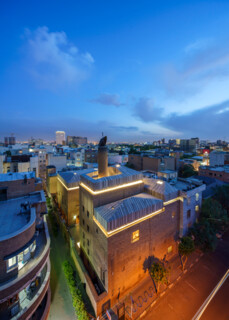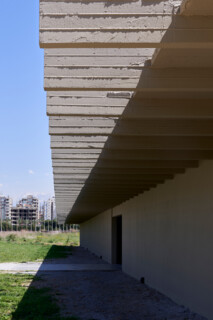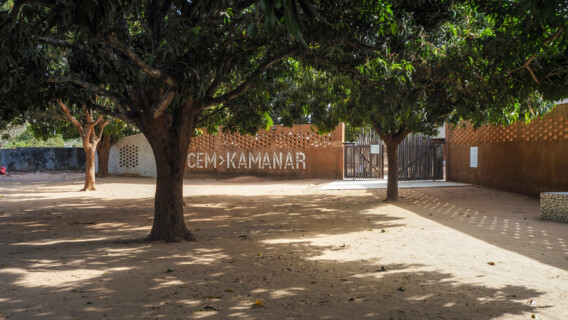- wa-ID
- wa-2031227
- Tag der Veröffentlichung
- 23.03.2021
- Aktualisiert am
- 10.10.2022
- Verfahrensart
- Award
- Zulassungsbereich
-
Andere
- Teilnehmer
- Architekt*innen
- Beteiligung
- 463 Arbeiten
- Auslober
- Aga Khan Development Network (AKDN)
- Bewerbungsschluss
- 15.09.2021
- Abgabetermin
- 15.11.2021
- 1. Jurysitzung
- 01/2022
- 2. Jurysitzung
- 07/2022
- Bekanntgabe der Gewinner
- 22.09.2022
Vielen Dank für Ihre Nachricht
Winner
Project: Urban River Spaces, Jhenaidah (Bangladesh)
Architect: Co.Creation Architects / Khondaker Hasibul Kabir, Suhailey Farzana
Client: Residents & Jhenaidah City Authority
Architect: Co.Creation Architects / Khondaker Hasibul Kabir, Suhailey Farzana
Client: Residents & Jhenaidah City Authority
-
Urban River Spaces, Jhenaidah (Bangladesh) | Aerial view of the large public ghat along the Nabaganga river in the city of Jhenaidah. | © Aga Khan Trust for Culture / Asif Salman (photographer)
-
Urban River Spaces, Jhenaidah (Bangladesh) | The area was difficult to access in spite of its central location. The municipality accepted to break paths in several walls in order to make the ghat and the river easily reachable. | © Aga Khan Trust for Culture / Asif Salman (photographer)
-
Urban River Spaces, Jhenaidah (Bangladesh) | The ghat was built with brick and concrete by local masons. It was designed with respect for the local topography. | © Aga Khan Trust for Culture / Asif Salman (photographer)
-
Urban River Spaces, Jhenaidah (Bangladesh) | The architects surveyed and documented all the trees in the city in order to propose ecologically significant vegetation and enhance the area's biodiversity. All the existing trees on-site were preserved. | © Aga Khan Trust for Culture / Asif Salman (photographer)
-
Urban River Spaces, Jhenaidah (Bangladesh) | The ghat is built on two levels connected by stairs and a ramp. | © Aga Khan Trust for Culture / Asif Salman (photographer)
-
Urban River Spaces, Jhenaidah (Bangladesh) | Stairs connecting the two levels of the ghat. | © Aga Khan Trust for Culture / Asif Salman (photographer)
-
Urban River Spaces, Jhenaidah (Bangladesh) | The ghat has become a popular place for the local people to exercise, enjoy an evening stroll, meet with friends or simply sit by the river. | © Aga Khan Trust for Culture / Asif Salman (photographer)
-
Urban River Spaces, Jhenaidah (Bangladesh) | Smaller ghats are built to accomodate the daily needs of the local communities who bathe, wash their clothes and fish in the Nabaganga river. | © Aga Khan Trust for Culture / Asif Salman (photographer)
-
Urban River Spaces, Jhenaidah (Bangladesh) | View of a small ghat used by the inhabitants of the village of Shatbariya. The circular structure adjoining the stairs is a changing room. | © Aga Khan Trust for Culture / Asif Salman (photographer)
-
Urban River Spaces, Jhenaidah (Bangladesh) | Master plan along the river. | © Co.Creation Architects / Khondaker Hasibul Kabir, Suhailey Farzana
-
Urban River Spaces, Jhenaidah (Bangladesh) | Plan of the public ghat. | © Co.Creation Architects / Khondaker Hasibul Kabir, Suhailey Farzana
-
Urban River Spaces, Jhenaidah (Bangladesh) | Shatbariya community ghat. | © Co.Creation Architects / Khondaker Hasibul Kabir, Suhailey Farzana
Winner
Project: Community Spaces in Rohingya Refugee Response, Cox’s Bazar (Bangladesh)
Architect: Rizvi Hassan, Khwaja Fatmi, Saad Ben Mostafa
Client: BRAC HCMP, ActionAid
Architect: Rizvi Hassan, Khwaja Fatmi, Saad Ben Mostafa
Client: BRAC HCMP, ActionAid
-
Community Spaces in Rohingya Refugee Response, Cox’s Bazar (Bangladesh) | Aerial view of the Shantikhana Women Friendly Space in Camp 4ext. The construction started before the design was finalised, allowing the local Rohingya workers to express their artisanal skills and artistic freedom. | © Aga Khan Trust for Culture / Asif Salman (photographer)
-
Community Spaces in Rohingya Refugee Response, Cox’s Bazar (Bangladesh) | Shantikhana Women Friendly Space in Camp 4ext: Eight main rooms of different shapes are arranged in a horse-shoe pattern around a central courtyard. A large roof made of bamboo and palm leaves covers all the rooms and interstitial areas, creating semioutdoor informal spaces. | © Aga Khan Trust for Culture / Asif Salman (photographer)
-
Community Spaces in Rohingya Refugee Response, Cox’s Bazar (Bangladesh) | The display centre in camp 11 provides Rohingya women with a facility to create, showcase and sell handmade products to visitors. The open courtyard connects the production workshop and the display centre. | © Aga Khan Trust for Culture / Asif Salman (photographer)
-
Community Spaces in Rohingya Refugee Response, Cox’s Bazar (Bangladesh) | The scarcity of land in the densely populated Camp 03 led architects to expand vertically. The two-storied community centre hosts various training programmes, awareness sessions, legal and psycho-social counseling and activities to strengthen and protect the community. | © Aga Khan Trust for Culture / Asif Salman (photographer)
-
Community Spaces in Rohingya Refugee Response, Cox’s Bazar (Bangladesh) | Children collecting water next to the Community Centre in Camp 03. | © Aga Khan Trust for Culture / Asif Salman (photographer)
-
Community Spaces in Rohingya Refugee Response, Cox’s Bazar (Bangladesh) | Aerial view of the Safe Space for Women and Girls in Camp 25. The activity areas and rooms are organised around an open courtyard, connecting them into one larger space. | © Aga Khan Trust for Culture / Asif Salman (photographer)
-
Community Spaces in Rohingya Refugee Response, Cox’s Bazar (Bangladesh) | The open courtyard of the Safe Space for Women and Girls in Camp 25 connects all the surrounding rooms. The shelter provides women of all age with sanitary facilities as well as a place for them to create and share. | © Aga Khan Trust for Culture / Asif Salman (photographer)
-
Community Spaces in Rohingya Refugee Response, Cox’s Bazar (Bangladesh) | The open courtyard of the Safe Space for Women and Girls in Camp 25 connects all the surrounding rooms. The shelter provides women of all age with sanitary facilities as well as a place for them to create and share. | © Aga Khan Trust for Culture / Asif Salman (photographer)
-
Community Spaces in Rohingya Refugee Response, Cox’s Bazar (Bangladesh) | The Bhalukia Community Centre serves the Bangladeshi host communities who were directly or indirectly affected by the Rohingya influx. The centre stands in an areca nut grove where all trees were preserved. | © Aga Khan Trust for Culture / Asif Salman (photographer)
-
Community Spaces in Rohingya Refugee Response, Cox’s Bazar (Bangladesh) | The Safe Space for Rohingya Women and Girls was designed with basic materials. The woven bamboo, straw thatching and tarpaulin used for construction could easily be sourced and would be less dangerous in the event of a cyclone, a frequent phenomenon in the region. | © Aga Khan Trust for Culture / Asif Salman (photographer)
-
Community Spaces in Rohingya Refugee Response, Cox’s Bazar (Bangladesh) | Women Friendly Space in Camp 4ext. | © Rizvi Hassan, Khwaja Fatmi, Saad Ben Mostafa
-
Community Spaces in Rohingya Refugee Response, Cox’s Bazar (Bangladesh) | Beyond Survival: A Safe Space for Women and Girls in Camp 25. | © Rizvi Hassan, Khwaja Fatmi, Saad Ben Mostafa
-
Community Spaces in Rohingya Refugee Response, Cox’s Bazar (Bangladesh) | Aloon Lar Shay Pha La (come and see us) - Display & Production Centre for Rohingya Women in Camp 11. | © Rizvi Hassan, Khwaja Fatmi, Saad Ben Mostafa
-
Community Spaces in Rohingya Refugee Response, Cox’s Bazar (Bangladesh) | Hindupara Integrated Community Center in Hindupara camp. | © Rizvi Hassan, Khwaja Fatmi, Saad Ben Mostafa
-
Community Spaces in Rohingya Refugee Response, Cox’s Bazar (Bangladesh) | Community Centre in Camp 03. | © Rizvi Hassan, Khwaja Fatmi, Saad Ben Mostafa
-
Community Spaces in Rohingya Refugee Response, Cox’s Bazar (Bangladesh) | Bhalukia Community Centre for Host Communities in Bhalukia, Ratnapalong. | © Rizvi Hassan, Khwaja Fatmi, Saad Ben Mostafa
Winner
Project: Banyuwangi International Airport, Blimbingsari, East Java (Indonesia)
Architect: andramatin
Client: PEMDA - Angkasa Pura II
Architect: andramatin
Client: PEMDA - Angkasa Pura II
-
Banyuwangi International Airport, Blimbingsari, East Java (Indonesia) | General view of the domestic airport that serves more than 110'000 passengers per day. | © Aga Khan Trust for Culture / Mario Wibowo (photographer)
-
Banyuwangi International Airport, Blimbingsari, East Java (Indonesia) | The building offers a contemporary interpretation of vernacular design principles. | © Aga Khan Trust for Culture / Mario Wibowo (photographer)
-
Banyuwangi International Airport, Blimbingsari, East Java (Indonesia) | The roof is divided in two sections to distinguish the departure and arrival halls. | © Aga Khan Trust for Culture / Mario Wibowo (photographer)
-
Banyuwangi International Airport, Blimbingsari, East Java (Indonesia) | The two-section roof covered by grass. | © Aga Khan Trust for Culture / Mario Wibowo (photographer)
-
Banyuwangi International Airport, Blimbingsari, East Java (Indonesia) | View of the open courtyard from above showing the landing track in the background. | © Aga Khan Trust for Culture / Mario Wibowo (photographer)
-
Banyuwangi International Airport, Blimbingsari, East Java (Indonesia) | The waterbody provides natural ventilation. | © Aga Khan Trust for Culture / Mario Wibowo (photographer)
-
Banyuwangi International Airport, Blimbingsari, East Java (Indonesia) | Waiting area by the waterbody. | © Aga Khan Trust for Culture / Mario Wibowo (photographer)
-
Banyuwangi International Airport, Blimbingsari, East Java (Indonesia) | Materials were selected for their local availability, functionality and low-cost maintenance. | © Aga Khan Trust for Culture / Mario Wibowo (photographer)
-
Banyuwangi International Airport, Blimbingsari, East Java (Indonesia) | Green area inside the airport. | © Aga Khan Trust for Culture / Mario Wibowo (photographer)
-
Banyuwangi International Airport, Blimbingsari, East Java (Indonesia) | Ground floor plan | © andramatin
Winner
Project: Argo Contemporary Art Museum and Cultural Centre, Tehran (Iran)
Architect: ASA North / Ahmadreza Schricker Design
Client: Pejman Foundation
Architect: ASA North / Ahmadreza Schricker Design
Client: Pejman Foundation
-
Argo Contemporary Art Museum and Cultural Centre, Tehran (Iran) | Aerial view of the museum by night. | © Aga Khan Trust for Culture / Deed Studio (photographer)
-
Argo Contemporary Art Museum and Cultural Centre, Tehran (Iran) | Insertion of a new foundation and metal structure to support the floating concrete floors and roofs independently of the original exterior walls. | © Aga Khan Trust for Culture / Deed Studio (photographer)
-
Argo Contemporary Art Museum and Cultural Centre, Tehran (Iran) | View of the white concrete grand staircase. | © Aga Khan Trust for Culture / Deed Studio (photographer)
-
Argo Contemporary Art Museum and Cultural Centre, Tehran (Iran) | The climate-controlled galleries offer diverse and generous ceiling heights up to 12 meters. | © Aga Khan Trust for Culture / Deed Studio (photographer)
-
Argo Contemporary Art Museum and Cultural Centre, Tehran (Iran) | Former basement cellars have been converted into sunken galleries. | © Aga Khan Trust for Culture / Deed Studio (photographer)
-
Argo Contemporary Art Museum and Cultural Centre, Tehran (Iran) | New insertions employ distinct materials to differentiate them from the historic structure. | © Aga Khan Trust for Culture / Deed Studio (photographer)
-
Argo Contemporary Art Museum and Cultural Centre, Tehran (Iran) | Restored brickwork is indicated by deeply recessed pointing. | © Aga Khan Trust for Culture / Deed Studio (photographer)
-
Argo Contemporary Art Museum and Cultural Centre, Tehran (Iran) | Insertion of new structural foundations, while retaining the expressive exposed brick load-bearing walls. | © Aga Khan Trust for Culture / Deed Studio (photographer)
-
Argo Contemporary Art Museum and Cultural Centre, Tehran (Iran) | The new floating concrete roofs in contrast with the old masonry walls. | © Aga Khan Trust for Culture / Deed Studio (photographer)
-
Argo Contemporary Art Museum and Cultural Centre, Tehran (Iran) | Ground floor plan | © ASA North / Ahmadreza Schricker Design
-
Argo Contemporary Art Museum and Cultural Centre, Tehran (Iran) | First floor plan | © ASA North / Ahmadreza Schricker Design
-
Argo Contemporary Art Museum and Cultural Centre, Tehran (Iran) | Second floor | © ASA North / Ahmadreza Schricker Design
-
Argo Contemporary Art Museum and Cultural Centre, Tehran (Iran) | Roof plan | © ASA North / Ahmadreza Schricker Design
Winner
Project: Renovation of Niemeyer Guest House, Tripoli (Lebanon)
Architect: East Architecture Studio / Nicolas Fayad, Charles Kettaneh
Client: Expertise France
Architect: East Architecture Studio / Nicolas Fayad, Charles Kettaneh
Client: Expertise France
-
Renovation of Niemeyer Guest House, Tripoli (Lebanon) | From the outside, a paved concrete pathway leads the visitors discreetly towards the building entrance. | © Aga Khan Trust for Culture / Cemal Emden (photographer)
-
Renovation of Niemeyer Guest House, Tripoli (Lebanon) | Central courtyard with the glazed partitions. | © Aga Khan Trust for Culture / Cemal Emden (photographer)
-
Renovation of Niemeyer Guest House, Tripoli (Lebanon) | Central atrium surrounded by the exhibition space, where furniture samples are tested and made available for public use. | © Aga Khan Trust for Culture / Cemal Emden (photographer)
-
Renovation of Niemeyer Guest House, Tripoli (Lebanon) | Conceived as an open production laboratory, the workshop and its auxiliary technical spaces infiltrate towards the western wing of the building. | © Aga Khan Trust for Culture / Cemal Emden (photographer)
-
Renovation of Niemeyer Guest House, Tripoli (Lebanon) | Defined by a series of lightweight steel and glass panels registering the ceiling's rhythmic structural grid, the new flexible partition allows for all functions to seamlessly connect to each other and to the central courtyard beyond. | © Aga Khan Trust for Culture / Cemal Emden (photographer)
-
Renovation of Niemeyer Guest House, Tripoli (Lebanon) | Since its opening, the Guest House hosted shows and promoted collaborations between established Lebanese designers and local artisans. | © Aga Khan Trust for Culture / Cemal Emden (photographer)
-
Renovation of Niemeyer Guest House, Tripoli (Lebanon) | Outdoor space. | © Aga Khan Trust for Culture / Cemal Emden (photographer)
-
Renovation of Niemeyer Guest House, Tripoli (Lebanon) | View of the horizontal concrete structure with a windowless façade. | © Aga Khan Trust for Culture / Cemal Emden (photographer)
-
Renovation of Niemeyer Guest House, Tripoli (Lebanon) | Site plan | © East Architecture Studio / Nicolas Fayad, Charles Kettaneh
Winner
Project: Kamanar Secondary School, Thionck Essyl (Senegal)
Architect: Dawoffice / David Garcia, Aina Tugores
Client: Foundawtion
Architect: Dawoffice / David Garcia, Aina Tugores
Client: Foundawtion
-
Kamanar Secondary School, Thionck Essyl (Senegal) | The modules are arranged in year-group classroom set around squares and existing trees. | © Aga Khan Trust for Culture / Amir Anoushfar (photographer)
-
Kamanar Secondary School, Thionck Essyl (Senegal) | The clay vault modules were produced using local techniques. | © Aga Khan Trust for Culture / Amir Anoushfar (photographer)
-
Kamanar Secondary School, Thionck Essyl (Senegal) | A series of squares articulate the space and give value to the pre-existant trees. | © Aga Khan Trust for Culture / Amir Anoushfar (photographer)
-
Kamanar Secondary School, Thionck Essyl (Senegal) | The vaults are made of compressed clay blocks. | © Aga Khan Trust for Culture / Amir Anoushfar (photographer)
-
Kamanar Secondary School, Thionck Essyl (Senegal) | Interior view of a classroom. | © Aga Khan Trust for Culture / Amir Anoushfar (photographer)
-
Kamanar Secondary School, Thionck Essyl (Senegal) | The clay and lattices act as an evaporating cooler: no artificial air-conditioning is required. | © Aga Khan Trust for Culture / Amir Anoushfar (photographer)
-
Kamanar Secondary School, Thionck Essyl (Senegal) | Each square is linked to a tree. | © Aga Khan Trust for Culture / Amir Anoushfar (photographer)
-
Kamanar Secondary School, Thionck Essyl (Senegal) | The building includes two administration volumes and sanitary facilities. | © Aga Khan Trust for Culture / Amir Anoushfar (photographer)
-
Kamanar Secondary School, Thionck Essyl (Senegal) | Outdoor seating shaded by a large tree. | © Aga Khan Trust for Culture / Amir Anoushfar (photographer)
-
Kamanar Secondary School, Thionck Essyl (Senegal) | Site plan | © Dawoffice / David Garcia, Aina Tugores
Verfahrensart
Award / Auszeichnung
Wettbewerbsaufgabe
Der Aga Khan Award for Architecture wird alle drei Jahre an Projekte verliehen, die neue Maßstäbe in den Bereichen Architektur, Planungspraxis, Denkmalschutz und Landschaftsarchitektur setzen. Mit dem Preis sollen Baukonzepte ermittelt und gefördert werden, die den Bedürfnissen und Bestrebungen von Gesellschaften auf der ganzen Welt, in denen Muslime eine bedeutende Rolle spielen, gerecht werden.
Competition assignment
The Aga Khan Award for Architecture is given every three years to projects that set new standards of excellence in architecture, planning practices, historic preservation and landscape architecture. Through its efforts, the Award seeks to identify and encourage building concepts that successfully address the needs and aspirations of societies across the world, in which Muslims have a significant presence.
Jury
The Steering Committee is chaired by His Highness the Aga Khan
Sheikha Mai Bint Mohammed Al Khalifa, President, Bahrain Authority for Culture and Antiquities, Manama
Emre Arolat, Founder, EAA- Emre Arolat Architecture, Istanbul
Meisa Batayneh, Principal Architect, Founder, maisam architects and engineers, Amman
Sir David Chipperfield, Principal, David Chipperfield Architects, London
Souleymane Bachir Diagne, Director, Institute of African Studies, Columbia University, New York
Nasser Rabbat, Aga Khan Professor, Massachusetts Institute of Technology, Cambridge
Marina Tabassum, Principal, Marina Tabassum Architects, Dhaka
Sarah M. Whiting, Dean, Graduate School of Design, Harvard University, Cambridge
Weitere Informationen zu den Gewinnern finden Sie unter | More information about the winners can be found at:
the.akdn/en/how-we-work/our-agencies/aga-khan-trust-culture/aga-khan-award-for-architecture/aga-khan-award-for-architecture-2022-winners
Award / Auszeichnung
Wettbewerbsaufgabe
Der Aga Khan Award for Architecture wird alle drei Jahre an Projekte verliehen, die neue Maßstäbe in den Bereichen Architektur, Planungspraxis, Denkmalschutz und Landschaftsarchitektur setzen. Mit dem Preis sollen Baukonzepte ermittelt und gefördert werden, die den Bedürfnissen und Bestrebungen von Gesellschaften auf der ganzen Welt, in denen Muslime eine bedeutende Rolle spielen, gerecht werden.
Competition assignment
The Aga Khan Award for Architecture is given every three years to projects that set new standards of excellence in architecture, planning practices, historic preservation and landscape architecture. Through its efforts, the Award seeks to identify and encourage building concepts that successfully address the needs and aspirations of societies across the world, in which Muslims have a significant presence.
Jury
The Steering Committee is chaired by His Highness the Aga Khan
Sheikha Mai Bint Mohammed Al Khalifa, President, Bahrain Authority for Culture and Antiquities, Manama
Emre Arolat, Founder, EAA- Emre Arolat Architecture, Istanbul
Meisa Batayneh, Principal Architect, Founder, maisam architects and engineers, Amman
Sir David Chipperfield, Principal, David Chipperfield Architects, London
Souleymane Bachir Diagne, Director, Institute of African Studies, Columbia University, New York
Nasser Rabbat, Aga Khan Professor, Massachusetts Institute of Technology, Cambridge
Marina Tabassum, Principal, Marina Tabassum Architects, Dhaka
Sarah M. Whiting, Dean, Graduate School of Design, Harvard University, Cambridge
Weitere Informationen zu den Gewinnern finden Sie unter | More information about the winners can be found at:
the.akdn/en/how-we-work/our-agencies/aga-khan-trust-culture/aga-khan-award-for-architecture/aga-khan-award-for-architecture-2022-winners
Aga Khan Award for Architecture 2022
Organizer
Aga Khan Development Network (AKDN)
1-3 Avenue de la Paix
1202 Geneva
Switzerland
Tel: +41 22 909 7200
E-mail: info@akdn.org
Competition Assignment
The Aga Khan Award for Architecture is given every three years to projects that set new standards of excellence in architecture, planning practices, historic preservation and landscape architecture. Through its efforts, the Award seeks to identify and encourage building concepts that successfully address the needs and aspirations of societies across the world, in which Muslims have a significant presence.
Competition Type
Award for Architecture
Admission Area
International
Eligibility
The Award seeks nominations that represent the broadest possible range of architectural interventions, but for the 15th cycle (2020-2022), it encourages the submission of projects in rural landscapes, urban peripheries and those that deal with public space at all scales.
To be eligible for consideration in the 2022 Award cycle, projects must be completed between 1 January 2015 and 31 December 2020 and should have been in use for at least one full year.
All individuals, organisations and firms are invited to submit projects to be considered for nomination directly to the Award by completing a simple form that is available online at www.akdn.org/architecture, or by sending an email to the Award office at akaa@akdn.org.
Steering Committee for 2022
The Steering Committee is chaired by His Highness the Aga Khan. The other members of the Steering Committee are:
Sheikha Mai Bint Mohammed Al Khalifa, President, Bahrain Authority for Culture and Antiquities, Manama.
Emre Arolat, Founder, EAA- Emre Arolat Architecture, Istanbul.
Meisa Batayneh, Principal Architect, Founder, maisam architects and engineers, Amman.
Sir David Chipperfield, Principal, David Chipperfield Architects, London.
Souleymane Bachir Diagne, Director, Institute of African Studies, Columbia University, New York.
Nasser Rabbat, Aga Khan Professor, Massachusetts Institute of Technology, Cambridge.
Marina Tabassum, Principal, Marina Tabassum Architects, Dhaka.
Sarah M. Whiting, Dean, Graduate School of Design, Harvard University, Cambridge.
Schedule
1 June 2020 – 15 September 2021: Identification and nomination of projects
1 June 2021 – 15 November 2021: Submission of project documentation
January 2022: Master Jury meeting I
February – April 2022: On-site project reviews
April 2022: Shortlisted projects announced
July 2022: Master Jury meeting II
Autumn 2022: Announcement of Awards and Award Ceremony
More information and details at
